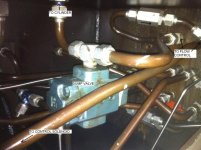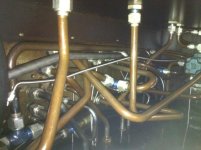Actually the HMI is kind of important to implement along with the PLC control of the bend angle - without it there is no way to pass the bend angle into the PLC... I guess for testing it could be done as constants in the ladder logic, but not very useful as a bender that way.
Let me go ahead and post all the info I have from the builder of the machine:
SPECIAL FEATURES:
Direct acting pressure die with a powerful pressure die assist (boost). High speed, tight radius, production bender (faster than a no. 2 or no. 4 Pines). Also an option to bend with one or two 5" bend cylinders. Main spindle is Æ8" and hydraulics features a separate system controlling the pressure die and boost.
The 'soft clamp' capability allows you to advance the mandrel in thin or soft material that hasn't been distorted by the higher typical clamping pressures required for bending. Maximum bend arm torque @ 2,000 psi = 32,436 Ft-lbs. Maximum centerline radius for Æ3" is 9" and for Æ5" is 5".
HOW THIS BENDER WORKS:
The 'Auto Bend' cycle works like this:
First, the selector switches in the left column must be turned to the neutral (vertical) position as shown above and the mandrel must not be fully advanced. Also, the bend tools must be manually tested for alignment and clearance to avoid crashes.
With the hydraulic motor on, press the 'auto bend' push button:
1. The clamp and pressure die will start to close. The clamp will not close to full pressure (the cylinder pressure will only increase to 500 psi) and the pressure die will stop short of close by activating its forward limit switch. The purpose for the lower clamp pressure is to allow the mandrel to advance without distorting the tube when clamping.
2. When pressure reaches 500 psi, a sequence valve will shift and the mandrel will advance. The mandrel cylinder must bottom, actuating its forward limit switch. This also causes the system pressure to increase.
3. The mandrel forward limit switch signals the pressure die to bypass the limit switch and go to the pressure setting of the pressure reducing valve. This pressure reducing valve is the middle of the three valves under the nose of the machine. Pull out and rotate clockwise will increase the pressure. Use only enough pressure to keep the tube from wrinkling.
The higher pressure will shift the boost cylinder sequence valve and the pressure die will 'boost' unless the needle valve on the boost cylinder is closed. At the same time, because the pressure in the mandrel cylinder exceeds 500 psi, the bend cylinder will be activated if the pressure die pressure switch is closed. Flow control valves will cause the main line pressure to rise to the relief pressure setting (usually 1800 psig) and this will cause the clamp cylinder to also rise to 1800 psig, increasing its clamping power. The speed of the bend arm should be only slightly metered so that bend arm speed can be kept high while allowing pressure to build above the bend resistance and reach the relief setting. The boost speed is maintained by it's flow control and not the needle valve. The flow control valve is the lowest of the three valves under the nose of the machine. Normally, lightly tighten its set screw after adjustments. Turning the knob clockwise slows the speed.
4. As the bend cylinder activates, the bend arm will rotate clockwise until the 'end of bend' turret assembly actuates the 'end of bend' limit switch. Then the bend arm stops rotating. This flow control valve is the highest of the three valves under the nose of the machine. Again, lightly tighten its set screw after adjustments. Turning the knob clockwise slows the bend arm.
5. The 'end of bend' limit switch actuates the mandrel extract and the mandrel is extracted until the cylinder rod actuates its mandrel extract limit switch.
6. The 'end of bend' and mandrel extract limit switches actuate the clamp and pressure die / boost cylinder to open and retract, respectively. If the pressure die opens to its rearmost limit switch before the boost cylinder has a chance to fully retract, you can close and open the pressure die selector switch which will provide more time for the boost to retract.
7. Observe the boost and pressure die positions. If they have fully returned, remove the bent tube. If the mandrel extract limit switch and the pressure die open limit switch are actuated, the return push button on the top row will return the bend arm. When the bend arm return limit switch has been actuated, the cycle is complete and the main hydraulic system will switch to de-vent. Take caution to make sure that the tube has been either placed in a safe position or removed so that the bend arm is free to return to the starting position.
OPTIONS:
· For 'kick' bends (approximately 30° or less), you can select the 'auto return' selector position and by adjusting the pneumatic timing control relay to the appropriate delay, the bend arm will automatically return. Make certain that the bent tube is clear when using this option.
· You can operate the machine in a semi-automatic mode by positioning the tube and manually clamping it, then turning the clamp selector switch to neutral and then pressing the 'auto bend' push button.
· You might also want to manually advance the mandrel, then extract it a short distance and then press 'auto bend'. However, be sure to place the clamp, pressure die and mandrel selector switches in the neutral position
· You might want to rework a tube by putting more bend into it. After the bend arm has been rotated to the desired rework position, follow the steps to return the bend arm BUT press the
· cycle interrupt mushroom head as soon as the bend arm starts to return. Then load the 'under bent' tube and follow the rest of the options (above).
.
SET UP
Set the bend angle by rotating a rod into position so that the slider will contact it and no other rods. This means that the larger bend angles will be set counter clockwise (left) of the smaller angles. Slide the turret left, slightly compressing the spring until you can fit a 0.625" shim between the turret and the stop collar. Then adjust the rod so that a space between the rod end and the slider is equal to (the bend angle + spring back) X 0.10.
Example: For a 90° bend, figuring 2° spring back, 92 X 0.10 = 9.2" of space.
Set the bend die in place making certain that all surfaces are clean and that the die is well supported on the die boss (does NOT rock). Fix the key in position to back up the clamp and if required, shim the top of the key so that it cannot twist or move when pressure is applied. Tighten the draw bolt to 80 - 120 ft-lbs. (darn tight).
Install the clamp die and pressure die. Align the clamp so that with a tube in it, it doesn't bottom out against the insert in the bend die. If you plan to use 'auto bend' instead of manual clamp, make certain that any alignment pins easily match their respective holes and a crash will not occur. When tightening the clamp, do not permit the back portion of the arm (back of lead screw) to drop more than 3/16". Otherwise too much pressure is being applied. Devices such as tight fitting plugs (inserted into the tube) will improve clamping.
Align the pressure die so that (under pressure) it groove is level with the bend die.
Install and align the wiper die so that there is a slight positive rake. Stainless steel requires less rake than carbon steel and a tighter radius also requires less rake. Also, it is very important to adjust the front to rear height to prevent wrinkles and marking.
With tooling properly installed, lubricate tube and wiper die, then load tube over mandrel until tangent of the bend die corresponds to the desired position on the tube. Manually clamp tube. Then with left hand touching tube and clamp insert to check for slippage, press the 'auto bend' push button keeping the right hand near the cycle interrupt button. If very slight slippage is detected, permit the bending to continue but if gross slippage is detected, press and hold the cycle interrupt button. Then while continue to hold the interrupt button, turn the mandrel to extract and then release the interrupt button. You can pulse this interrupt button to aid the mandrel extraction.
Turn off the motor when cleaning the dies or otherwise having your hands in the clamping or pressure die area.






